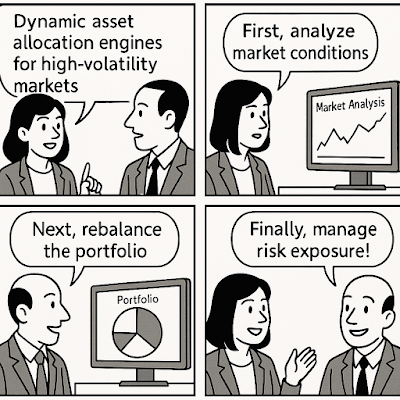Dynamic Asset Allocation Engines for High-Volatility Markets
Dynamic Asset Allocation Engines for High-Volatility Markets
Market volatility has become a constant challenge for investors—from geopolitical disruptions to inflation surges and unpredictable central bank policies.
Static portfolio strategies often fall short in such conditions. This has accelerated the adoption of dynamic asset allocation engines powered by artificial intelligence and real-time market signals.
These tools are helping asset managers, hedge funds, family offices, and fintech startups rebalance portfolios proactively based on changing risk profiles, macro indicators, and asset class behavior.
📌 Table of Contents
- ➤ Why Dynamic Allocation Matters
- ➤ Common Models Used in Allocation Engines
- ➤ Core Features of a Modern Allocation Engine
- ➤ Use Cases Across Volatile Environments
- ➤ How to Build One Yourself
📉 Why Dynamic Allocation Matters
Traditional allocation relies on periodic rebalancing (quarterly or annually) based on fixed asset class weights (e.g., 60/40 equity/bond).
But in times of rapid interest rate shifts or geopolitical stress, asset correlations can break down quickly.
Dynamic allocation engines adjust exposure based on real-time data, helping preserve capital, reduce drawdowns, and exploit short-term opportunities.
🧠 Common Models Used in Allocation Engines
Dynamic engines typically use a blend of quantitative and AI-based methods, including:
• Risk Parity — balances portfolio weights based on volatility contribution
• Regime Switching Models — adjust based on bull/bear/sideways markets
• Mean-Variance Optimization with forward-looking estimates
• Reinforcement Learning for adaptive strategies
• Hidden Markov Models to detect market phase transitions
These approaches generate allocation signals that can be executed algorithmically or via portfolio manager oversight.
⚙️ Core Features of a Modern Allocation Engine
A robust engine should offer:
• Integration with market data APIs (Bloomberg, Alpha Vantage, Quandl)
• Real-time volatility forecasting
• Asset class scoring (e.g., based on momentum, valuation, sentiment)
• Automatic rebalancing with rule-based constraints (e.g., ESG screening)
• Risk budgeting and scenario stress testing tools
Ideally, the engine outputs allocations in human-readable reports and machine-readable formats (JSON/CSV/XML).
📈 Use Cases Across Volatile Environments
Dynamic engines shine in the following scenarios:
• Navigating central bank policy shifts (e.g., tapering cycles, rate hikes)
• Responding to black swan events (e.g., pandemics, war, flash crashes)
• Managing pension portfolios with glide-path adjustments
• Allocating capital across crypto and DeFi assets
• Dynamic ESG investing based on evolving sustainability scores
By rebalancing daily, weekly, or even intraday, these engines reduce portfolio whiplash.
🛠 How to Build One Yourself
If you're a developer or quant, building your own dynamic engine requires:
• Python (with libraries like pandas, NumPy, scikit-learn, PyPortfolioOpt)
• A backend to host signal generation and strategy execution (e.g., Flask + PostgreSQL)
• A frontend dashboard using Streamlit or Dash for performance visualization
• Integration with broker APIs (Alpaca, Interactive Brokers, Tradier)
You’ll also need a secure logging and alert system to manage trade risk and compliance.
🔗 Related External Resources
Here are trusted sources on portfolio optimization and dynamic asset allocation systems:
Keywords: dynamic asset allocation, AI portfolio rebalancing, volatility risk management, adaptive investment strategy, financial machine learning
